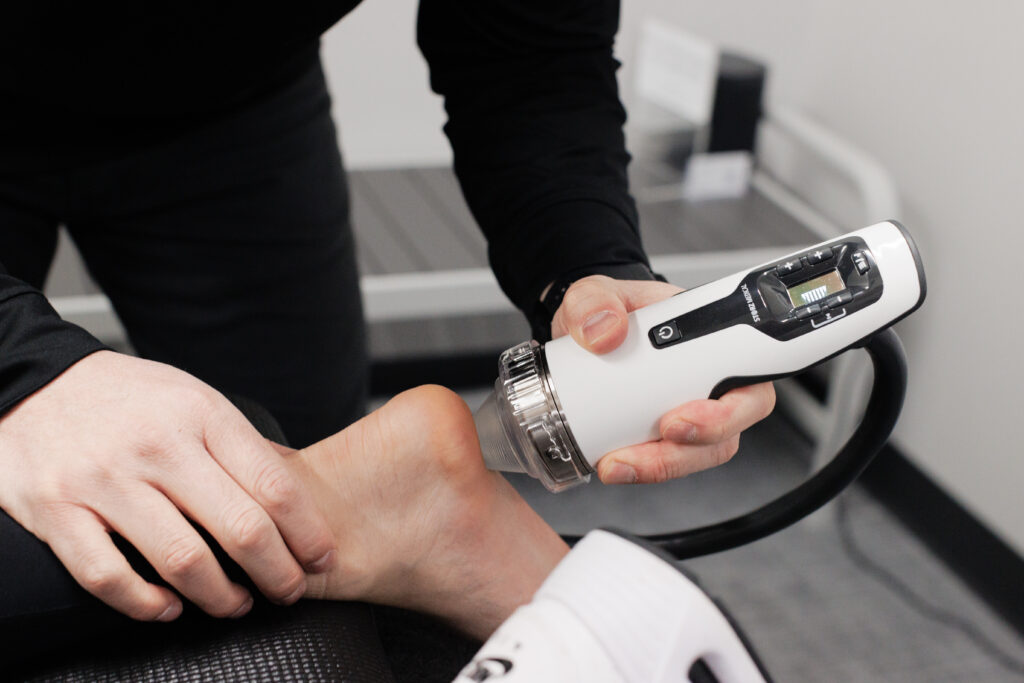Shockwave therapy has gained popularity for its effectiveness in treating chronic pain, tendon injuries, and musculoskeletal dysfunction. But what most patients—and even some providers—don’t realize is that not all shockwave therapy is the same. There are key differences in both the type of shockwave and the quality of the device used, and these differences can significantly affect outcomes.
Let’s break it down.
Focused vs. Radial Shockwave Therapy
Shockwave therapy falls into two main categories: focused shockwave therapy (FSWT) and radial pressure wave therapy (RPWT)—commonly, though inaccurately, both are referred to as “shockwave.”
Focused Shockwave Therapy (FSWT)
Focused shockwaves are true acoustic shockwaves, created using electrohydraulic, electromagnetic, or piezoelectric methods. These waves are high-energy, precisely targeted, and converge at a specific depth within the tissue, allowing them to reach deep structures like tendons, bones, or joints.
- Depth of penetration: Up to 12 cm
- Energy delivery: High, focused
- Indications: Chronic tendinopathies (e.g. Achilles, rotator cuff), plantar fasciitis, bone non-unions, myofascial trigger points, erectile dysfunction, and calcific deposits
- Mechanism: Microtrauma at cellular level, stimulating angiogenesis, collagen remodeling, and neurogenic inflammation modulation
Radial Pressure Wave Therapy (RPWT)
Radial devices, by contrast, emit pressure waves that disperse outward from the applicator head. These are lower-energy, superficial, and better suited for larger surface areas or more superficial soft tissue treatments.
- Depth of penetration: Up to 3–4 cm
- Energy delivery: Lower, dispersed
- Indications: Muscle tightness, superficial tendinopathies, trigger point work, and circulatory conditions
- Mechanism: Increases local circulation and reduces muscle tone; less effect on deep tissue remodeling
Clinical Implications
A 2015 meta-analysis published in The American Journal of Sports Medicine found that focused shockwave therapy showed superior results in chronic plantar fasciitis when compared to radial pressure wave therapy (Gerdesmeyer et al., 2008). The takeaway? If your condition is deep, chronic, or involves hard-to-reach structures, focused shockwave therapy is likely the more effective option.

Not All Devices Are Created Equal
Even within each category of shockwave, device quality matters—a lot. Many clinics advertise shockwave therapy but use low-cost, imported machines that do not meet the energy output, depth, or safety standards required to achieve clinical success.
The Rise of Low-Cost Devices
With the growth in popularity of shockwave, budget machines (often manufactured in Asia or Eastern Europe) have flooded the market. These devices typically cost a fraction of the price—sometimes under $5,000 compared to $30,000+ for high-quality systems—but they come with significant trade-offs:
- Inconsistent energy output
- Poor depth penetration
- No clinical research backing
- Lack of regulatory approvals (e.g. FDA, CE marking)
- Less durable parts and service issues
These devices may offer some symptom relief through massage-like effects but are not capable of true regenerative outcomes, particularly in chronic or complex cases.
The Gold Standard: Storz Medical
When it comes to shockwave technology, Storz Medical is considered the gold standard. Manufactured in Switzerland, Storz devices are used in top research studies and elite sports medicine settings globally.
What Sets Storz Apart?
- Proven outcomes in hundreds of peer-reviewed clinical studies
- Consistent energy delivery with precise calibration
- Deep penetration capabilities with focused heads reaching up to 12 cm
- Interchangeable applicators for both radial and focused applications
- FDA-cleared and CE-certified
- Service and training support from experienced medical professionals
Whether it’s the Duolith SD1 Ultra (focused) or Masterpuls Ultra (radial), these systems have been used in elite sports medicine, including by organizations like FC Barcelona, the German National Soccer Team, and major orthopedic centers across the U.S.
Why This Matters for You as a Patient
Imagine going to two different clinics for “shockwave therapy” for your Achilles tendinopathy.
- At Clinic A, they use a $3,000 radial device from an unknown brand, offering superficial tissue stimulation and calling it “shockwave.”
- At Clinic B, they use a Storz Medical focused system, capable of delivering targeted energy directly to the degenerative tendon tissue.
The experience—and more importantly, the outcomes—will be vastly different.
Choosing the right technology is as important as choosing the right provider.
How to Ask the Right Questions
If you’re exploring shockwave therapy, don’t be afraid to ask:
- Is this focused or radial shockwave therapy?
- What brand of machine do you use?
- Is the device FDA-cleared or CE-certified?
- What conditions is it best suited for?
- Do you have clinical protocols and outcome data?
Being informed helps you avoid wasting time and money on ineffective treatments.
Final Thoughts: Invest in What Works
Shockwave therapy can be a game changer for chronic pain, soft tissue injuries, and stubborn musculoskeletal problems. But only when it’s done right.
- Focused shockwave therapy is superior for deep, chronic, and calcific issues.
- Radial pressure wave therapy is helpful for more superficial conditions.
- Device quality—especially gold-standard brands like Storz Medical—matters.
At our clinic, we use Storz Medical technology because we believe in offering our patients evidence-based treatment with the best tools available.
Call-to-Action
Ready to experience the difference high-quality shockwave therapy can make?
Schedule a $49 Shockwave Diagnostic Session at Central Ohio Spine & Joint to find out if focused shockwave therapy is right for you.
Gerdesmeyer L et al., Extracorporeal Shock Wave Therapy for Chronic Plantar Fasciitis, The American Journal of Sports Medicine (2008)

Recent Comments